Okinawa’s most iconic Goya Champuru is a bitter melon stir-fry with tofu, egg, and pork belly. This popular savory dish is a truly rustic yet well-balanced meal. You can serve it as your main entree with steamed rice and miso soup on the side.
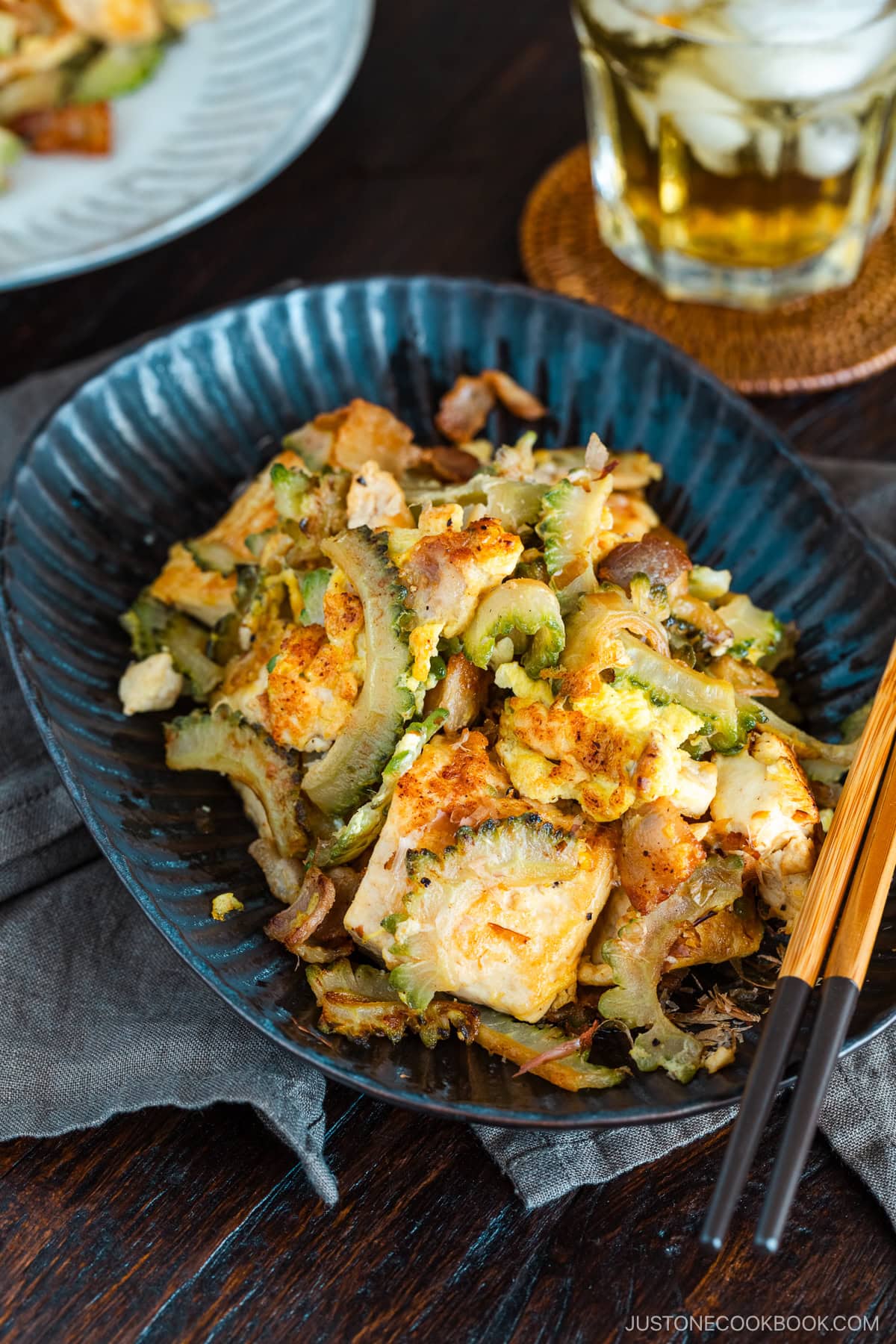
Goya Champuru (ゴーヤチャンプル) is a popular stir fry dish that came from the sunny island of Okinawa in southern Japan. Made with vibrant green bitter melon, tofu, pork belly, and egg, it is packed with protein and nutrients.
As I am planning my first trip to Okinawa this winter, I am excited to discover many more delicious Okinawan dishes. But first, let me introduce this simple yet absolutely healthy home-cooked dish of Okinawa – Goya Champuru with you.
What is Goya Champuru?
Goya (ゴーヤ) is an Okinawan dialect of Nigauri (にがうり). In English, it’s bitter melon or bitter gourd. As you can probably guess, bitter melon is famous for its bitterness, but it is remarkably nutritious.
Chanpurū (チャンプルー) refers to Okinawan stir-fry dishes, meaning “something mixed” in Okinawan. Stir-fry dishes are a big part of Okinawan cuisine. There are different types of champuru. Usually, it contains tofu with some kind of vegetables, meat, or fish. Common ingredients include spam, pork, egg, bean sprouts, and bitter melon. Spam is not typically used in mainland Japan, but Okinawan cuisine uses spam due to the influence of the US Navy.
Growing up in Yokohama (Tokyo area) between the ’70s and ’90s, Okinawan restaurants were rare to find and I had never had a chance to try Okinawan dishes.
Through the NHK TV drama “Churasan” (ちゅらさん) broadcasted in 2001, many people became interested in Okinawan culture and visited Okinawa on vacation. The popularity of Okinawan food spread all over mainland Japan, and we started seeing more Okinawan restaurants everywhere. Even Japanese housewives started to cook Okinawan dishes at home.

5 Health Benefits of Bitter Melon
- Treats skin conditions. Bitter melon juice has powerful antioxidants with Vitamin C and A, which prevent premature skin aging, diminish wrinkles, reduce acne, and help in treating eczema. The amount of vitamin C in bitter melon is four times more than in lemon and five times more than in tomatoes. Usually, vitamins get lost by being cooked, but not for bitter melon, which is why it’s perfect to cook Goya Champuru
- Lowers bad cholesterol levels. Studies have shown that the juice from bitter melon significantly reduces the risk of heart attack and stroke and keeps the heart healthy.
- Helps maintain blood sugar levels. Studies have also shown that eating bitter melon on a regular basis significantly reduces the blood sugar level for patients suffering from type-1 and type-2 diabetes.
- Prevents cancer. Those bitter flavors contain components that reduce blood sugar levels and cholesterol. Studies have also shown positive correlations between eating bitter melon and preventing or reducing tumor growth in cervical, prostate, and breast cancer patients.
- Boosts your immune system. Bitter melon is a source of many different antioxidants that make it a powerful defense mechanism against illnesses in the body.
How to Choose the Bitter Melon
Bitter melon season in Japan is from July to September. These days, bitter melon is also available at farmers’ markets or Asian grocery stores in the US. For the best taste, choose bitter melon in a relatively smaller size with lots of bumps. The surface should be fresh and shiny green, and you want to pick one that feels firm to the touch.
How to Store the Bitter Melon
To keep bitter melon fresh for a longer time, remove the seeds and pith first as they go bad quickly. Make sure you remove the inner white pith clean as that’s where the bitterness most concentrates. After slicing, you can store them in an airtight container in the refrigerator for later use.
How to Reduce Bitterness of the Bitter Melon
I learned to sprinkle some salt, but I also heard that enhances the bitterness instead. Some suggest cooking in lightly salted boiling water, then again I heard the method also causes bitterness. I assume everyone’s grandma suggests different things and you just need to try out the method that works for you. I use the salt method as it draws out moisture with some bitter flavors.
This amazing gourd may have an acquired taste, but there are plenty of good reasons to eat it. In this homey Okinawan stir fry, crunchy crisp bitter melon is combined with soft creamy tofu and cooked in a delicious umami-rich dashi and soy sauce seasoning. It’s truly a healthy and everyday meal you can serve for the family. I’d like you to give it a try.
Do you have any experience cooking with bitter gourd (goya)? What are your favorite ways of cooking with it? How do you remove the bitterness of the gourd? Share with us in the comment below!
Other Bitter Melon Recipe
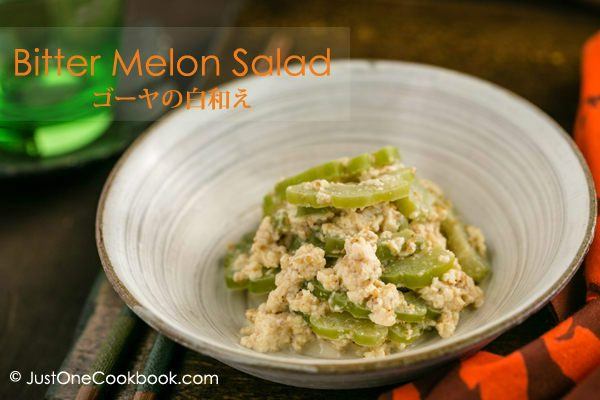
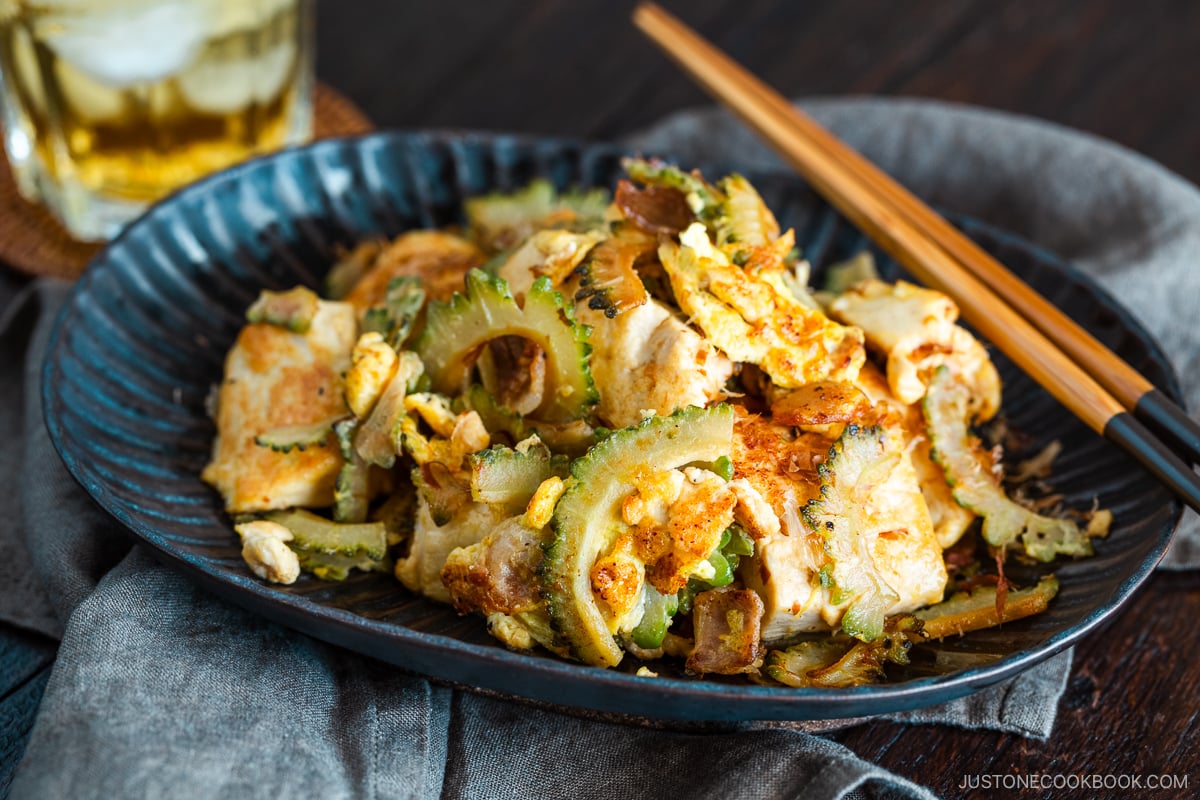
Wish to learn more about Japanese cooking? Sign up for our free newsletter to receive cooking tips & recipe updates! And stay in touch with me on Facebook, Pinterest, YouTube, and Instagram.
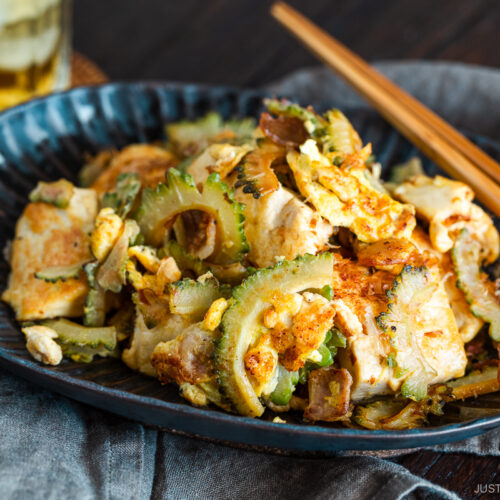
Goya Champuru
Video
Ingredients
- 1 bitter melon (8 oz, 227 g)
- 1 tsp Diamond Crystal kosher salt (for the bitter melon)
- 14 oz medium-firm tofu (momen dofu)
- 6 slices sliced pork belly
- 2 large eggs (50 g each w/o shell)
- 2½ Tbsp neutral oil (divided; to fry the tofu, bitter melon, and pork)
- ¼ tsp Diamond Crystal kosher salt
- ⅛ tsp freshly ground black pepper
- 1 Tbsp soy sauce
For the Katsuo Dashi
- 3 Tbsp katsuobushi (dried bonito flakes) (I use 1 (3 g) packet and more for garnish)
- ¼ cup boiling water (4 Tbsp)
Instructions
- Gather all the ingredients.

To Prepare the Ingredients
- First, make the katsuo dashi. Add 3 Tbsp katsuobushi (dried bonito flakes) into a measuring cup and add ¼ cup boiling water. Let it steep until you’re ready to cook. Right before you start cooking, strain and remove the katsuobushi (you can reserve it to make Homemade Furikake Rice Seasoning). Tip: Alternately, you could use a dashi packet or dashi powder in a pinch or Vegan Dashi for vegan/vegetarian.

- Cut 1 bitter melon in half lengthwise. Using a spoon, scrape out the seeds and inner white pith.

- Thinly slice the bitter melon crosswise about ⅛ inch (3–4 mm) thick. Sprinkle 1 tsp Diamond Crystal kosher salt and toss well. Let stand for 10 minutes.

- Meanwhile, wrap 14 oz medium-firm tofu (momen dofu) with a paper towel. Place a heavy flat object, like a cutting board, on top of the tofu to squeeze out the water. I use flat trays to sandwich the tofu and place a marble mortar on top.

- After 10 minutes, quickly rinse the bitter melon with water and drain well. I use a salad spinner to get rid of the moisture easily.

- Cut your 6 slices sliced pork belly into 1½-inch (3.8-cm) pieces.

- Beat 2 large eggs (50 g each w/o shell) in a medium bowl. Now, tear the drained tofu with your hands into bite-size pieces.

To Cook
- Heat a large frying pan and add 1 Tbsp neutral oil. Put the tofu in the pan.

- Try not to touch the tofu frequently. Cook until the tofu is browned and the moisture has evaporated. Transfer to a plate.

- Add 1 Tbsp oil to the same frying pan. Add the bitter melon and spread it out in the pan.

- Sprinkle with 1 pinch kosher salt and stir-fry until almost cooked. Transfer to a plate.

- Add ½ Tbsp oil to the pan and add the pork belly. Season with 1 pinch kosher salt and ⅛ tsp freshly ground black pepper. Stir-fry until nice and golden brown.

- Add the bitter melon and the tofu back into the frying pan.

- Add the katsuo dashi and 1 Tbsp soy sauce. Let the liquid evaporate while you toss to combine.

- Taste the dish. Add kosher salt and freshly ground black pepper, if necessary. Use salt to enhance the flavor instead of adding soy sauce.

- Add the beaten eggs to the frying pan and shake it to cook the egg. Once the egg is no longer runny, turn off the heat.

To Serve
- Transfer to a serving plate and sprinkle with more katsuobushi (bonito flakes). Enjoy!

To Store
- You can keep the leftovers in an airtight container and store in the refrigerator for up to 3 days or in the freezer for a month.
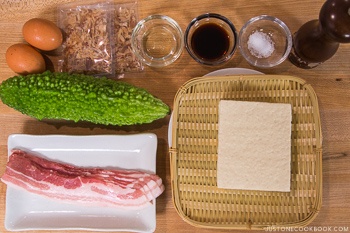

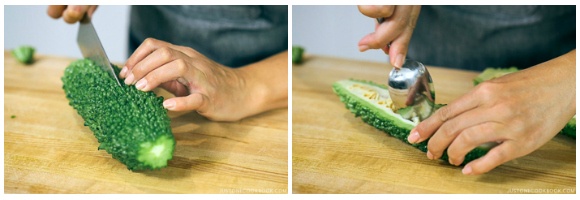




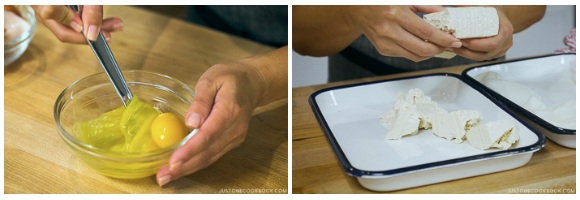

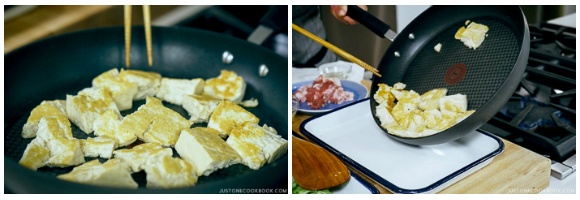
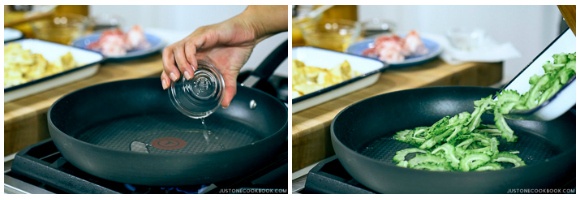
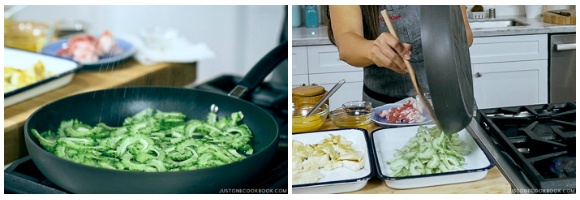

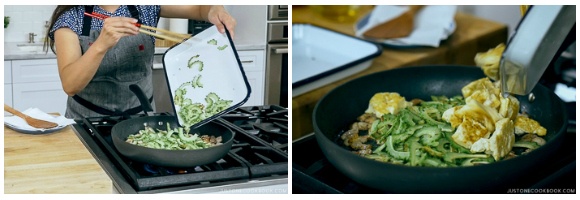
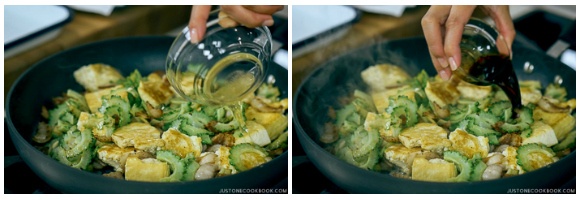
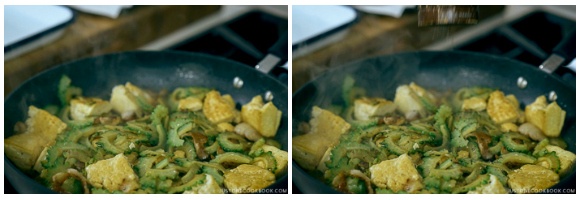
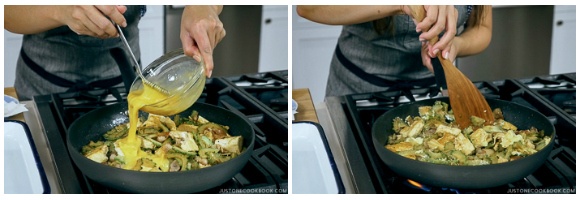
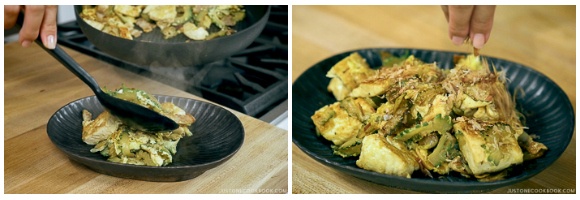











I made this without pork belly or eggs and it tastes great. I added grated carrots with goya and finished it with mashed yam instead of eggs.
I love how bitterness is just one note of the entree it is neither hidden nor covered with spices as most Indian recipes cook it.
Hi Salina! Thank you for reading Nami’s post and sharing your experience with us!
We are glad you enjoyed the bitterness of Goya.😊
Hi Nami, my mother is 94 yrs old, born and raised in Okinawa. We live in Southern California and she grows beautiful goya in her backyard! I now do most of the cooking which is mainly American dishes. I made your recipe exactly as written and she absolutely loved it!! She actually had it for breakfast, lunch, and dinner. Thank you so much for making my mom smile with your awesome recipe! ❤️
Hello, Cindy (Misako)! Aww. What a heartwarming story.❤️
We are certain that homegrown Goya elevated this meal to new levels!
Thank you for trying Nami’s recipe and sharing your joy with us.
Hi Nami, I was interested to see your recipe stacked up against the ones I’ve been taught (I’ve been living in Okinawa for about 12 years now). There are a couple of things I thought you might be interested to know.
1. I’ve always been taught to leave the salt on the sliced goya for at least 30 minutes. Maybe this will help more with the bitterness? Also, we don’t wash the salt completely off. This helps season everything later, and we don’t add more salt into the pan.
2. I was also taught a few variations:
– add 1/4 tsp honey or maple syrup or sugar to the finished champuru for a bit of sweetness
– try adding onion or shredded carrot while the goya is cooking
3. In Okinawa, many people substitute Spam for the pork belly, or some people use both pork belly and Spam!
Hello, Valerie! Thank you very much for reading Nami’s post and sharing your method of cooking Goya and other Champuru variations.
There are several methods, and we always appreciate learning from readers like you.
Thank you for taking the time to reach out to us! Happy Cooking!
This was so delicious! Thank you for the recipe, Nami. I doubled the recipe since I had two bitter melons, but left out the pork belly and used one 16 oz container of tofu. The method of first cooking the tofu made it stay crisp and tasty. I scrambled the eggs separately, then added everything back in. I had never thought of adding bonito dashi to stir fry, but it added such a nice smokiness to the dish. Will be making this again and again!
Hi Ellie! Thank you so much for trying Nami’s recipe and sharing your cooking experience with us.
We are so happy to hear you enjoyed the recipe and technique. Happy Cooking! 🥰
In my grocery store I can only find Chinese or Indian bitter melon…the Japanese variety almost looks like a mix of the two…for the purpose of cooking Okinawan dishes, which of these two might be better?
Hi Connor, Thank you very much for reading Nami’s post and trying her recipe!
Both kinds work for this recipe, but Indian bitter melon is closer to the Japanese bitter melon.
We hope this helps!
Very delicious dish, definitely going to make this weekend. Bitter gourd is a very common vegetable in my country and we make different ways – like curry, fried with onions etc. I love bitter gourd as well. Actually, when it comes to removing the bitterness my mom adds about quarter cup of coconut water (roughly) when cooking curries. I have a few recipes on my blog
Hi chelvi, Thank you very much for reading Nami’s post and sharing your cooking experience with us!
Happy Cooking!
Nami-San,
Greetings from a Texan living in Okinawa! My family has been enjoying my attempts at re-creating your dishes, so I figured it’s about time I drop a note and say, “Thank you.” I’ve found your recipes to be both time-saving and quite tasty. I cooked your goya champuru today, and my wife agreed it was pretty good for a gaijin! 🙂
Thanks again,
Jeff
Hi Jeff! Thank you very much for sending kind feedback from Okinawa!
Nami is so happy to hear you enjoyed her Goya Champuru and many of her recipes. Happy Cooking!🍱
My mom sometimes adds Okinawa fu in this and serves with rice. I love this stuff. It’s interesting to see Okinawan cuisine becoming more popular! You can also make a drink out of goya. Mix it with a drink like Sprite. The fizziness and sweetness make this more palatable.
Hi DelMar! Thank you very much for reading Nami’s post and sharing your experience with us!
Goya drink sounds very refreshing and yummy! 🤩
Thanks for your bitter melon recipe. I love bitter melon – with all its bitterness. Breakfast recipe would have it with egg, can of tuna or mince pork (whatever left over meat available I have). Sometimes, we have it with shrimp paste, a lot of tomato and of course egg. I put bitter melon on soup, stri fry. I am yet to try making it as a juice. Back home we call bitter melon as ampalaya, and it looks different from the japanese variety. I use both the japanese variety and other asian variety of the bitter melon.
By the way, our trick of making it less bitter (so kids will eat) is to microwave it for 1 to 1:30 minutes before cooking or eating it in a salad/pickle.
Hi Jovita! Wow, Thank you very much for sharing your cooking experience and tips with us! We have to try the microwave method next time! Happy Cooking!
Hi Nami! I wanted to watch Churasan again after all these years and can’t find it. 🙁 Your recipe popped up in the search though. Thanks!
Hi Ralph, Hum… We are not sure where to find Churasan online.. Maybe there is a DVD?
Before I cut the bitter melon in half and remove the seeds and pith, I take a carrot peeler and remove some of the green bumps on the outside as that seems to be very bitter. I will then boil the bitter melon for 15 minutes using water and a little bit of soy sauce..sometimes I may even sprinkle in a little bit of cinnamon.
Hi Philip,
Wow! Thank you for sharing your cooking experience and tips with us!
I’ll have to try making it your way one day.🙂
I grew up eating goya (ampalaya in my national language) and was missing it. So, I made this dish tonight. So happy!I It was so good. Thank you!
Hi JD,
Thank you very much for trying this recipe and for your kind feedback. I’m so glad to hear you enjoyed the dish!
When I was growing up, in our household, we used to cook bitter melon with canned sardines in tomato sauce, as well as coconut cream/milk, chili and pork (if pork was expensive, then canned sardines in tomato sauce).
Hi JD,
WOW! Thank you very much for sharing your cooking experience with us!
It’s so many ways to enjoy Goya! I’ll have to try making it your way one day.🙂
Nami-san! Love your beautiful website!!!
I’m from Surinam (small country over Brasil) but I live in the Netherlands. In Surinam we’re used to eating bitter vegetables (f.e. boulangé, a bitter kind of nasu). Sliced bitter melon (or Sopropo as we call it) is left in salty water for 30 minutes. Then rinse it and squeeze it until most of the water is out. Stove it together with chopped onion. Finally we add smoked salmon flakes to it and season it with some freshly grinded black pepper. Sometimes if we feel like eating it very spicy, we add a Madame Jeannette (a small yellow pepper) during the stoving proces. Delicious with a bowl of hot steaming rice! (Not low carb of course)
Hi Jeannet! Thank you so much for your feedback. It was interesting to hear about how the bitter melon is cooked there. Sounds like a delicious dish!